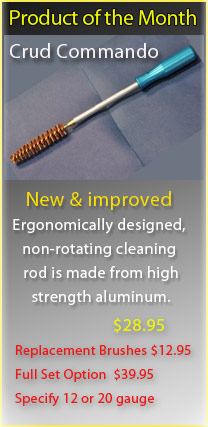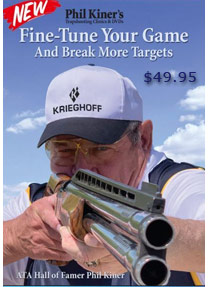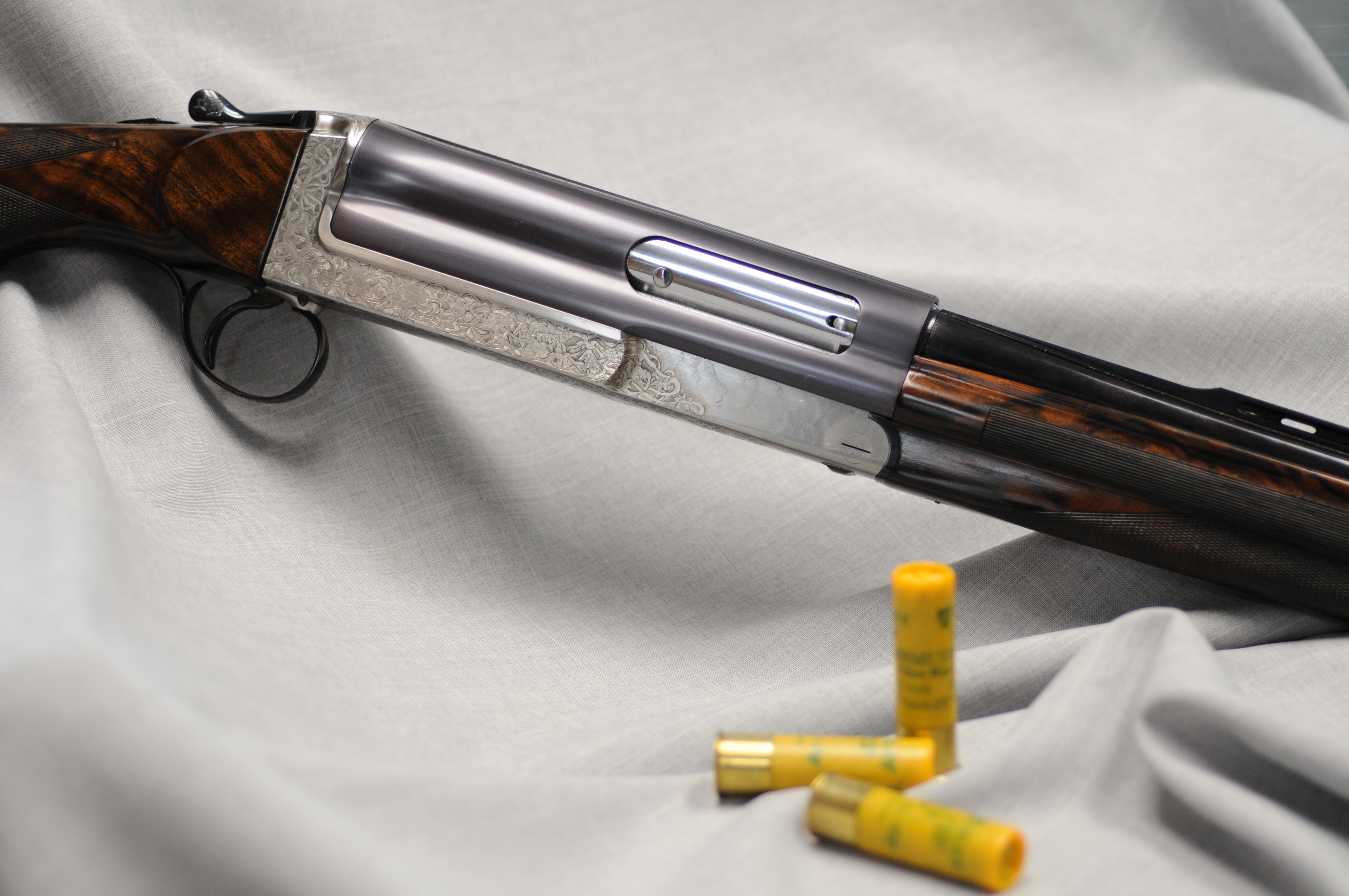
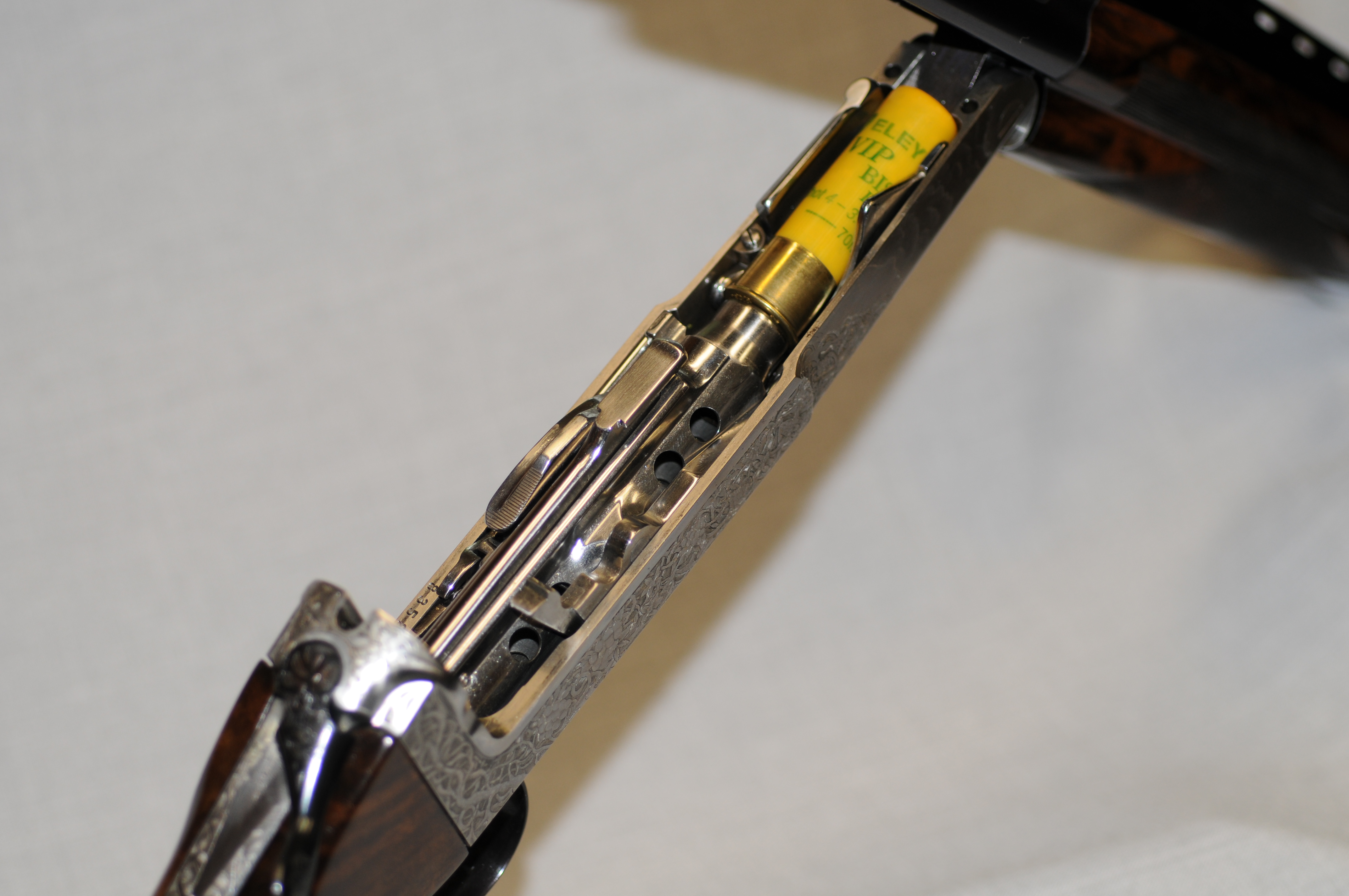
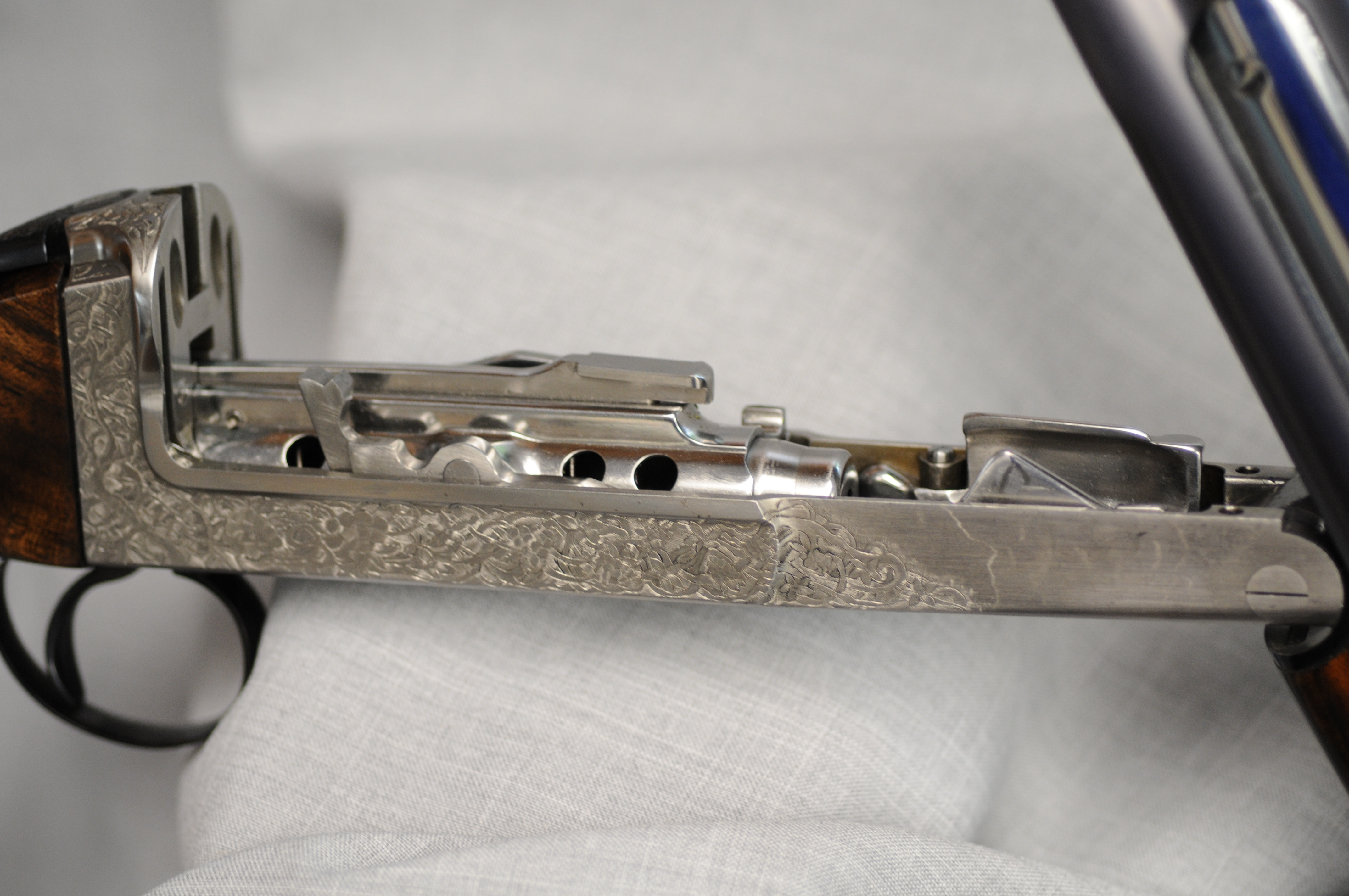
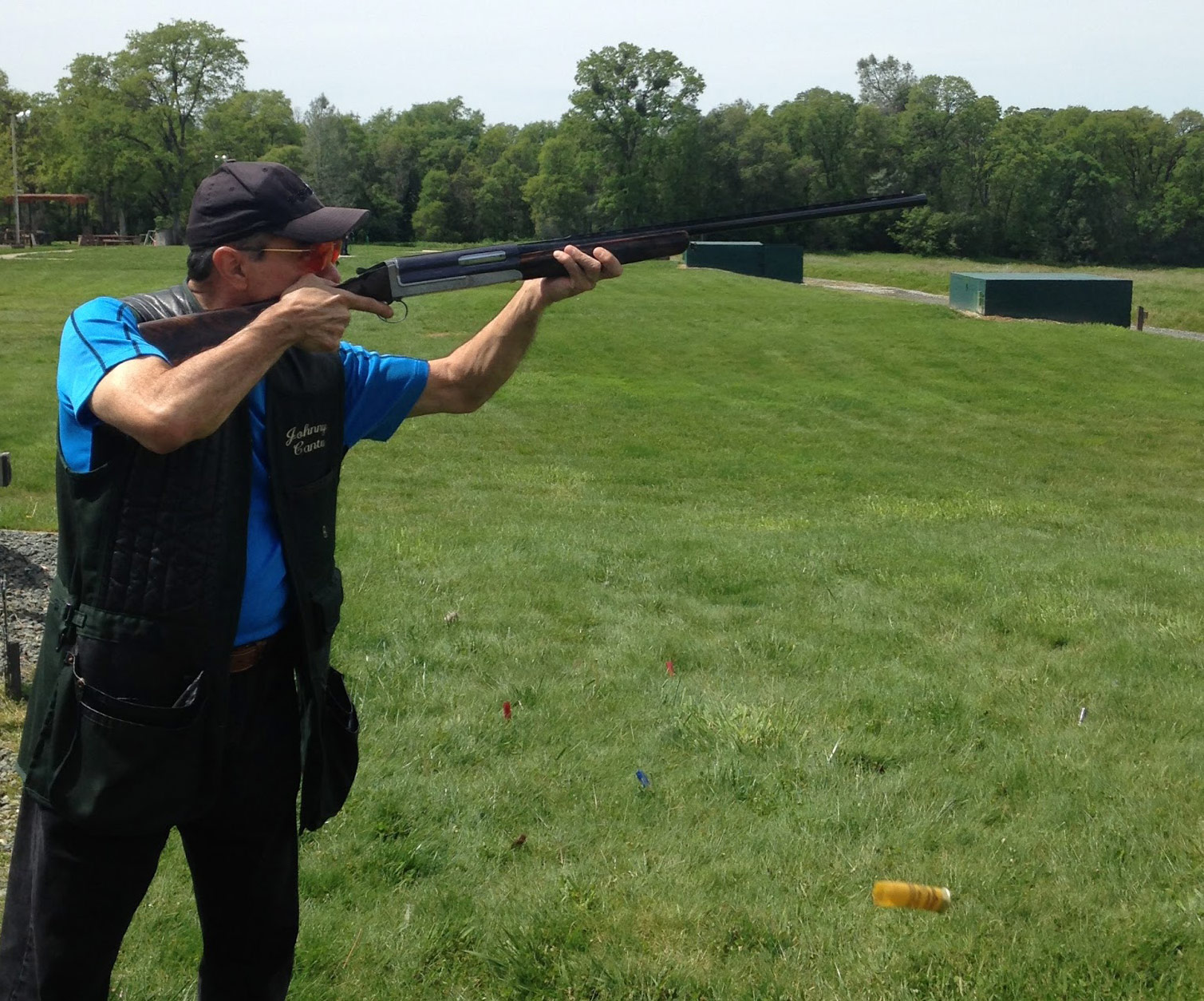
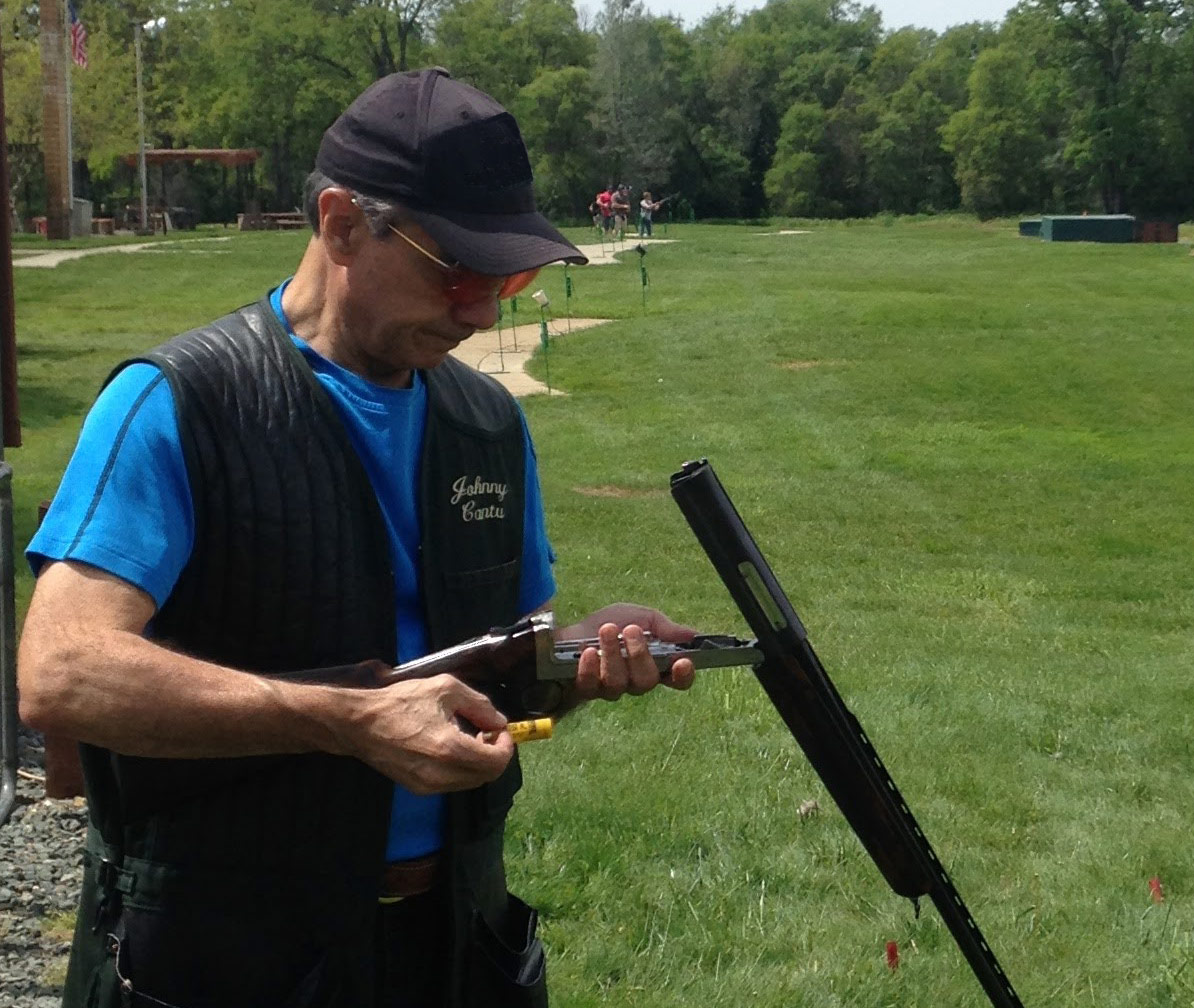
How much would you pay for a good semi-automatic shotgun? $500, $1,000, $1,500, $2,000?
Would you pay $17,000 for a no-frills, plain, standard-grade semi-auto? Most people probably would not. But then, the brand of semi-automatic shotgun I am talking about is not your average brand with a familiar name you can purchase almost any day of the week from your local sporting goods store. Nor does the company producing this brand of semi-automatic shotgun spit them out every few minutes off a production line. No, sir. Each one of these shotguns requires a minimum of 400 hours to produce with all parts being hand-polished and hand-fitted.
An interesting point about the design of this semi-automatic, not a single screw is found anywhere among the more than 100 parts of the working internal mechanism.
This shotgun is unique in other ways as well. It is indeed a semi-automatic. However, the receiver breaks open like a single-barrel gun. The shells are inserted into a magazine tube in the buttstock via the receiver. The receiver is scaled proportionately to each gauge: 12, 16, 20, 28 and .410. These guns have been owned by Hollywood movie stars, U.S. presidents and heads of state, both famous and infamous.
I think by now I have your attention. This unique shotgun is produced by the Cosmi Company in Ancona, Italy. What began as a thought in the mind of 20-year-old Rodolfo Cosmi took its earliest physical form from a pile of scrap of old rifles and a stick from a herding umbrella intended to be the barrel. This early design worked, even though merely a first attempt to build a working shotgun. This first attempt was improved upon time and again. Rodolfo soon was making his shotgun for friends and neighbors and in 1895 established his first Cosmi workshop.
But Rodolfo Cosmi, though brilliant, full of passion to see his ideas come to life and artistically inclined, was self-taught. Rodolfo needed to acquire greater technical skills if he wanted to succeed in making the designs in his head become a reality. For a few years, he spent his time in England acquiring the skills he needed at many of the finest gunsmithing shops in London. This time was invaluable to Rodolfo if he was to make his dream come true.
As they used to say in the old movies and books, “Time Passes”. Since those early years, the Cosmi Company has made a name for themselves in the world market and a reputation as a small company with traditional craftsmanship and a globally recognized name brand.
Let’s take a closer look at this unusual yet unique firearm. I first heard the name of Cosmi back in the ’80s when I was spending a good deal of my time traveling the national skeet tournament circuit. I do not recall where or who mentioned it, but I do remember the description of the gun. It was a semi-auto that broke open like an over/under or single-barrel gun with the lop lever on the upper tang. At the time, I was sure the person was making up the description of the alleged firearm. But not many years later, I had my first person-to-Cosmi experience. To this day, I am still amazed at the technological brilliance of this design and the beauty of the Cosmi.
My test gun came to me care of the friendly folks at Pacific Sporting Arms in Azusa, CA. Proprietor John Herkowitz and his General Manager Jordon Hirschi maintain an impressive inventory of high-end, clay-target grade shotguns. Not long ago, while I was visiting the Pacific Sporting Arms building at the National Shooting Complex during the NSCA Sporting Clays National Championships, John asked if I would like to do a review on the Cosmi. I quickly responded I would enjoy writing about this famous and enigmatic firearm. He said, “I have just the one for you. I’ll send it to you.”
He wasn’t fooling. The Cosmi he sent is a beauty. The receiver is adorned with fine-line Bulino engraving depicting ancient Greek mythological personages, I believe they are called Satyrs, in what would best be described as mature themes. Cosmi produces only semi-automatic shotguns, but the options available are limited only by the customer’s imagination and health of his checkbook. I have seen images of Cosmi shotguns that are truly stunning works of art. The internet has many photos of beautifully engraved Cosmi guns.
Cosmi shotguns can be ordered with 2¾” or 3″ chambers (when gauge appropriate). My sample gun came to me in 20 gauge. High-strength carbon steel, light-alloy and titanium receivers are available. The light-alloy and titanium receivers make for an exceptionally fast-handling and easy-to-carry gun in the field. Fixed or interchangeable chokes are available to order. Barrels are made from Boehler Antinit steel. The wood components of the well-dressed Cosmi are, of course, as you might suspect, amazing. The high-grade European walnut buttstock and forearm are finished in a hand-rubbed oil. Checkering can be whatever the customer desires, but my sample maintained a classic point style in what appeared to be 21 lines per inch. The butt end of the stock may be capped with a checkered wood end, a standard recoil pad or handsome leather-wrapped pad.
The first thing you notice when handling the Cosmi is the slenderness of the frame and overall svelte feel of the gun. The forearm is a splinter forearm. I certainly can’t think of a better descriptive call-out for this thin, splinter of wood. It is a mere 39.1 millimeters wide at its widest, and the 8 1/8″ long tapered receiver is only a hair wider at 39.8 mm. The concept of having your hands as close as possible to the centerline of the shotgun you are holding is seen vividly in the Cosmi. When I was the Firearms Sales Manager at the Beretta Gallery in Dallas, TX and the original Beretta Gallery in Alexandria, VA, I would often explain to my customers how the natural pointing aspect of a shotgun is accentuated in the hands when the centerlines of the gun’s barrels are kept as close to one another as possible, thereby falling in line with the natural centerline of your hands. This tight alignment of centerlines of the gun and the shooter’s hands make for a more natural, flowing and alert gun. I have seen some very tight centerline-based shotguns before, but nothing to compare with the Cosmi. Being it is a single-barrel gun makes it the ultimate example of this design concept.
The mechanism of the Cosmi operates on a long recoil system. The ventilated rib atop the Cosmi’s 27″ barrel of my test sample is relieved for the first 3½” inches to allow it to drive rearward into the receiver under recoil, thus ejecting the spent shell and loading a new one from the magazine, much like the Browning A5 design, Franchi AL and several others. The rebound spring is mounted under the barrel and hidden by the slender forearm.
Unlike other semi-automatics, the Cosmi’s bolt has no bolt handle attached to it. So you will need to become familiar with the correct loading procedure. Loading a single shell into the chamber can be accomplished by either dropping a shell into the chamber when the bolt is locked back and the ejection port is open, then pushing the bolt-release button on the left side of the receiver. Otherwise, when the bolt is closed, simply open the upper section by moving the top lever to the right, then lift back on the lever mounted on the underside of the bolt and pull the bolt to the rear of the upper receiver section. This will expose the chamber’s breech. Drop in a shell, push the bolt down to close against the chamber and close the gun. You are now ready to fire. One fair word of warning, the rebound spring that closes the bolt on the Cosmi is quite powerful. Best not to have your finger in or near the ejection port when the bolt slams forward.
To load shells into the Cosmi’s magazine tube, open the upper receiver/barrel section. Next, push and hold down the bolt-release button on the left side of the receiver. This allows you to insert shells into the centrally located magazine tube, brass end to the back. Remember, this is a straight-line feed design from the buttstock. The brass end of the shell goes into the magazine tube first. Once you have loaded the magazine tube with your desired number of extra rounds, close the upper receiver back down and you’re ready to fire.
The manual “Safety” is located just behind the top lever on the upper tang, and it is pushed “On Safe” by your thumb with a push to the rear exposing the letter “S”. The reverse movement takes it “Off Safe”.
I received one choke with my test sample Cosmi, a screw-in choke with three notches on the muzzle edge. These notches are generally recognized as indicators of the constriction in the choke relative to the bore size. Since I do not possess a 20-gauge bore reader with which to measure the bore or the choke of the Cosmi, I had to go by the indication given by the notches on the choke (which would be a Modified) and my knowledge that the nominal internal diameter of a typical 20-gauge bore measures .615. A constriction of Modified in a 20-gauge choke would likely measure around 15 to 18 thousandths tighter than the bore. In ballpark numbers, this would work out to be an I.D. at the muzzle of the choke of around .597 to .600. Armed with this information and a few boxes of NobelSport 20-gauge Sporting Clays loads launching 7/8 of an ounce of hard, target-destroying #8s, the Cosmi and I headed for the 5-Stand course at Auburn Trap Range near my office.
I could not have asked for a better day to test a gun. The temperature was in the low to mid 60s, the wind was slight and the sun and clouds were in perfect harmony, allowing the targets to be seen clearly against the background. The perfect conditions of the day were in stark contrast to the earlier part of the week when rain and cold winds had been prevalent. The 5-Stand course was, therefore, heavily attended this day. I knew I would have to wait a while before an opening on a squad would become available. Not to worry, as this gave me some extra time to go over the Cosmi before pressing it into duty on clay birds.
Once a spot opened on a squad, I unzipped the padded case I had brought the Cosmi in and almost at that same moment I had a crowd looking to see “what Cantu brought out this time!” Only one or two of the shooters at the club this day had ever even heard of the Cosmi, much less actually seen one in the flesh, so to speak. I gave the Cosmi-ized version of my usual dog-and-pony show; explaining the mechanism, showing how it loads and feeds extra shells from the mag and so on. All were quite impressed. Time to shoot!
As I have mentioned a time or two before, the property line and shot fall constraints of the Auburn Trap Club only allow for so much to be made available with regard to target presentations. Considering these constraints, volunteers Dennis and Barbara who manage the 5-Stand course, do a superb job of making the course fun, challenging and one you want to come back to.
My first shot with the Cosmi (which happened to be my FIRST shot with a Cosmi, period) did not connect with the very tall Springing Teal (#9 trap). However, that was not what I was paying much attention to. What caught my eye was the speed and velvet-smooth working of the action under recoil. Most semi-automatics make that familiar but mostly annoying “shuucck-shuucck” chatter when cycling a fired round and supplying the chamber with a fresh round from the magazine tube. Not so with the Cosmi. The fine watch-like quality of the hand-polished and hand-fitted parts made no discernible ruckus. The spent hull exited the gun very quickly and without hesitation, landing in the grass a good 15′ or 20′ away.
I was soon hitting targets with authority. The Modified choke worked well teamed with the hard 8s of the NobelSport Sporting Clays loads. This gun was an absolute joy to shoot. I could not get over the lack of recoil. Granted, it was a semi-automatic in 20 gauge, but really it felt like a .410 semi-auto. That is not an exaggeration. I have shot .410s before in semi-automatics that gave the same or more recoil than this 20 gauge.
I was asked by several of the lady shooters that day to take a few shots with this very beautiful gun. Upon closer inspection of the Bulino engraving, they had one thing to say, “This gun is a work of art.” After shooting the Cosmi, about all they could say was “Amazing, unbelievable, there’s no recoil.” One lady went so far as to say (looking at her husband) “Honey, I want one.”
The Cosmi was a huge hit with all who felt and/or shot it. One thing brought to my attention after we had all finished shooting for the day was how clean the gun was internally. I had to look. Sure enough, the photos that accompany this review show a very clean mechanism before several boxes of rounds had been through it. However, the internal works looked just the same afterward. That is a welcome side effect of such finely fitted parts.
This is a remarkable gun design. It is not inexpensive, but if you are in the market for a high-grade gun that will perform to your grandest expectation and awe your friends and compadres, the Cosmi is the gun to consider. Please check out the Cosmi and other high-grade shotguns offered by the dealers in this issue of Shotgun Sports and, of course, with our friends at Pacific Sporting Arms (see their ads on pages 3 and 35). Tell them Johnny sent you. SS

